|
Tuesday – April 19, 2011 Flight Day
Everett, good neighbor of the century, picked us at 4:45 a.m. and drove us to the airport.
The flights between San Diego, Dallas, Miami and Quito were all on time and very uneventful – just as one would want. I read my book, “The Beak of the Finch” about Darwin’s finches in preparation for the Galapagos part of the trip. It’s an excellent read.
We got into Quito about 10:00 p.m. and met Sofy, our tour guide. Only one other person from the Overseas Adventure Travel (OAT) tour, Fran from Hawaii, came in on our flight. The other 12 people are already at the hotel – probably in their beds. (Later, on the trip, the group came to love and respect Fran. She’s 90 years old – but you’d never know -- a very “with it” person.)
We’re pleased with our accommodations, Hotel Reina Isabel. It’s very nice and in a good location.
Wed. April 20, 2011—Exploring Quito
We got up early for breakfast and a full day of touring Quito with Sofy. The breakfast buffet was lovely. The first morning at the breakfast buffet table can be tricky business, trying to figure out where everything is –bread, toaster, coffee, juice, etc. My oh my, ain’t life tough?
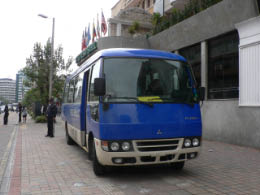
Our bus in Quito |
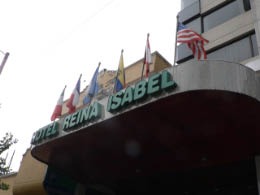
Hotel Reina Isabel, Quito |
After breakfast, we boarded the bus and headed out for our first stop – the National Basilica (La Basilica del Voto Nacional). It’s a huge gothic Roman Catholic cathedral, modeled on Paris’s Notre-Dame, and sits up high on a hill. (It reminded us of the very gothic Duomo in Milan). Although they started building the cathedral in 1892, it’s still not finished.
On one side of the cathedral there is a busy plaza (or square) hugging the steep slope. A statue of someone famous stands centered in the square anchoring the place and making it look very official. In the square, the vendors sat waiting for tour buses who deliver their prey. They were mostly women selling scarves, a few kids and one guy selling paintings. I got caught up in the moment and bought a couple of scarves. (One is now at home as a runner on my dining room table.)
On the other side of the cathedral is a magnificent view overlooking Old Town. We didn’t have time to climb to the top of the towers to take in the view, but we have a full day ahead.
We entered the National Basilica with its high arches and rose windows. It seemed cold with so much unfinished concrete, but the stained-glass windows were exquisite. The exterior is dripping with gothic-style gargoyles. However, these gargoyles are not your typical “goblin-style.” Instead the goblins are monkeys, penguins, tortoises, condors, etc. They represent the area – oh so weird and so charming.
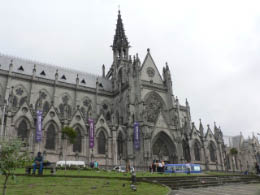
National Basilica |
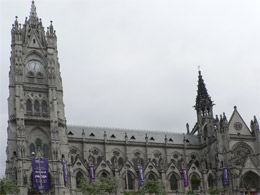
National Basilica |
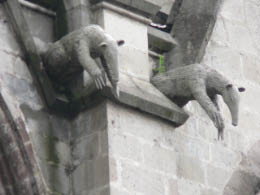
Gargoyles |
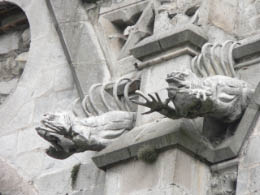
Gargoyles |
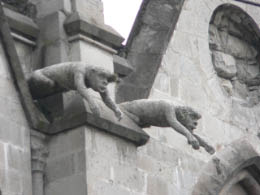
More gargoyles |
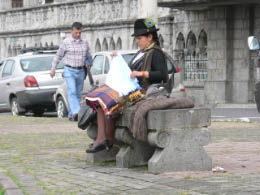
Local vendor |
We boarded the bus again and drove through Old Town with our jaws dropping. Quito is like San Francisco, hilly and loaded with character. Quito was the first city in the world to become a UNESCO World Heritage Site. A lot has been done to restore the city and keep the place clean and quaint. However, the fumes from buses and cars dashing through the narrow streets aren’t helping any.
We got off the bus at lovely hotel right across the street from the basilica. We didn’t go into the basilica, but had a quick tour of the hotel’s open courtyard. The hotel was once a mansion for the wealthy Spaniards who took over a destroyed Quito in1534. (When the Spaniards captured Quito, the Incas destroyed the town just as they were leaving.) Spanish mansions are like Pandora’s Box. From the narrow street, you see only rows of buildings with the occasional big entry door. Once inside the door, the grand courtyards make you feel you’re in the country.
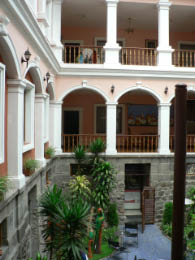
Hotel across the street from the basilica |
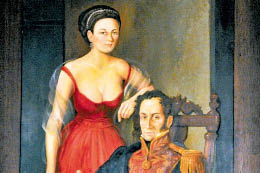
Simon Bolivar and his mistress |
Sofy took us to a painting of Simon Bolivar meeting his mistress, Manuela Saenz, and told us their story. Simon Bolivar (1783-1830) was one of South America's greatest generals. His victories over the Spaniards won independence for Bolivia, Panama, Colombia, Ecuador, Peru, and Venezuela. In fact, Bolivia is named after him. He is called El Liberator (The Liberator) and the "George Washington of South America." However, before he died, the newly–created South American republics fell into anarchy and disorder before they got it right (or sort of right).
Simon had a torrid love affair with Manuela Saenz. She was born an illegitimate child of a nobleman, but rose to the rank of general in Bolivar's rebel army. She was married to an Englishman, but once she met Bolivar, forget that Brit. Simon and Manuela’s passion could fill an epic novel. They were both brave warriors and no doubt, very feisty. She dressed in military uniforms as part of her job and for their rendezvous. She used a sword and even saved Simon from assassination. She was by Simon’s side when he died on December 17, 1830 from tuberculosis. Although he died unpopular and disillusioned, he became the true hero of Latin America. We saw statues of the two all over town.
We walked to Independence Square (Plaza de la Independencia), the main square of Quito. In the 16th Century, the Spanish were afraid the Incas might poison their water supply so they set up their own protected well here. Then this plaza became the social center of town, serving as a central market and bullfighting area – and now the political center of Quito.

Quito Grand Plaza |
A statue, “Monument to the Heroes of Independence,” stands in the center of the square and is dedicated to the triumph over the Spanish. It was erected in the early 20th century and looks like most other statues to independence found anywhere in the world. A tall pillar holds a winged figure of justice at the top, plaques of historic scenes are mounted on the sides, and respected animals are scattered about the base (lion, condor, etc). Each item has its symbolic meaning.
Quito is surrounded by volcanoes. Sofy pointed out the Pichincha Volcano in the hills beyond Old Town. Pichincha had its last big belch in 1999 and covered the city in several inches of ash. Sofy remembers how the city worked frantically to clear the ash off the rooftops before the rains came – all in an effort to save the tile roofs from being destroyed in a layer of “cemented” ash.
Sofy gave us some time in the square to explore on our own. Bill went around with his video camera, I with my still camera, documenting all the new sights. The square was loaded with people – mostly locals enjoying the lovely park. Four main buildings lined the sides of the square -- the Primary Cathedral, the Archbishop’s Palace, the Municipal Palace and the Presidential Palace.
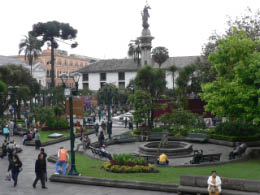
Grand Plaza |
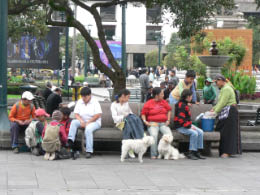
Grand Plaza |
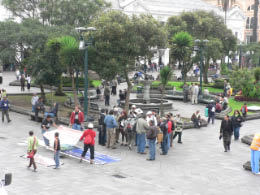
Grand Plaza |
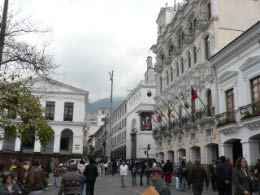
Grand Plaza |
A group of about 20 Petroleum Ecuador employees gathered in front of the Presidential Palace and were demanding to speak to the President. Apparently this is typical – sometimes the president comes out or invites them in for an audience. They were holding signs and yelling something in unison -- protesting something that had to do with oil pricing or wages or the amount of oil profits going to the government.
We would come to learn a lot about President Rafael Correa (elected in 2007). He’s 48 and a left-leaning economist and a real fighter. He stands up to anything and everything.
| He is making huge changes in the country. At the same time he is criticized for being too powerful. He is both respected and feared. He could become a dictator who happens to wear a white hat.
He doesn’t live in the Presidential Palace on the square. His Belgium wife is not interested in politics so they have their home elsewhere. (I think Sofy likes the president and feels he is making good changes for the things that count – national medical coverage, education, building roads, and reaping 50% of the oil profits for the people.) |

President Rafael Correa |
We went inside the corridor of the Presidential (or Government) Palace. The architectural style is Spanish/Moorish and by far, the most interesting building on the square. We first stopped to pose for photos with the two guards posted outside. Those poor guys must be almost nuts having to put up with tourists all day long – hope they don’t have real bullets in their guns.
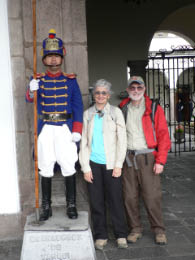
Bill and Nancy with Presidential Guard |
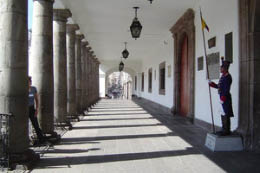
Corridor of the Presidential Palace |
Sofy pointed out the treasures just inside the corridor – the mosaics, the wrought iron chandeliers (purchased from the the Tuileries Palace in Paris just after the French Revolution), the model of the square, the 1966 mural by Guayasamín, of Orellana discovering the Amazon and other items that now escape me.
We walked out of the palace and down the street busy with traffic and people. We saw the 17th century Saguario Church, which used to be part of the Primary Cathedral. |
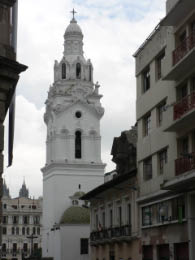
Saguario Church |
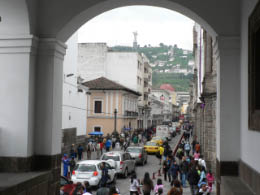
Exiting the Plaza |
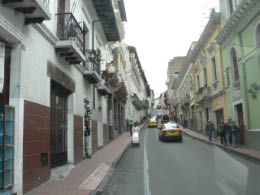
Quito |
We walked through a very large, impressive library (formerly the first University for Jesuits). Sofy took us to a courtyard with a couple of palm trees. Just inside one of the rooms was where Frair Eugenion Espejo (1747-1795) lived for a while. He was a mestizo, European and indigenous. He was a learned man. He first became a doctor/scientist and figured out that micro-organisms had something to do with spreading small pox, so he enlightened the people on the importance of hygiene. He later became a lawyer, then a journalist who printed his ideas about freeing the country (then a colony) from the corrupt, oppressive Spanish. (He was like a Thomas Paine or Thomas Jefferson who spread radical ideas about freedom.) As one might guess, because of his ideas, he was persecuted by the Spanish and landed in prison where he died. However, he lives on as the most important figure in colonial Ecuador.
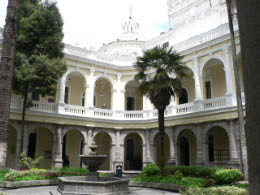
Library |
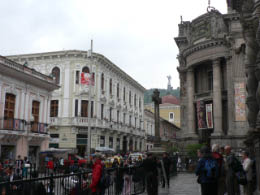
Outside Iglesia de la Compania |
Next we visited the Iglesia de la Compania, (Society of Jesus), the gold studded church. I’ve visited a lot of churches in my day, but I’ve never seen one like this. The place was blanketed in gold leaf – 7 tons of it – gold, Gold and more GOLD. Everything but the pews and floor were covered in it. (Sorry, no photos allowed so I’ve got nothing to document the blinding walls and ceilings.)
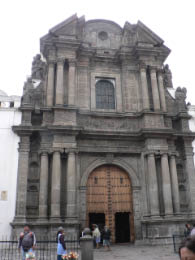
Iglesia de la Compania |
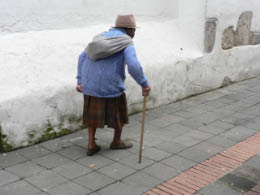 Old Woman in old town Old Woman in old town |
Sofy said around the 1700’s, the Spanish commissioned the building of about 30 churches in Quito– and this was just one of them. The powerful Jesuits were the force advocating for plenty of exquisite places of worship. The construction was approved, then halted in 1725 for lack of funds. Work began again and the place was wrapped up in 1760.
Not only was this church dripping in gold, the architects had a strong need for symmetry. On the back wall were the stairs to the choir loft on the left. On the right wall, there was a painted rendition of the same stair case with proper dimension making the place look like it had 2 identical stair cases – very odd.
To help you view the place, a moveable mirror was mounted at the main altar. You could swivel the mirror at different angles to see all the rich golden carvings on the ceiling. After a while, one was on total overload – a visual feast for the eyes.
An entire chapel to the left of the main altar holds the remains of Santa Mariana de Jesus, the Lily of Quito. The story goes that Quito had a long string of natural disasters and disease in the 17th century. In 1645, at the age of 26, a nun, Marianan, offered her life to God to spare the city any more grief. (I guess she killed herself.) Her blood was sprinkled in a garden. Later a pure white lily popped up and the city was forever grateful.
We went downstairs to use the bathroom and ogle at more treasures. After the pit stop, we stopped in at the sacristy, the room that stored the vestments and church furnishings. Its walls were covered in amazing paintings and along a sidewall there sat a huge elaborate carved wood cabinet containing several small drawers. This was the church’s “safety deposit box.” The padres knew the secret code and combination to open the drawers in the correct sequence in order to get at the funds, which must have been immense.
In another room we saw life size figures carved from wood and painted. The paint was in perfect condition, making them look like they were made of porcelain. We learned the secret to their preservation – the artists covered them with sheep bladders, stretched over the completed product. (Wonder how many sheep gave their lives for this treasure trove of statues?)
Walking back through the sanctuary on our way out of the church, I saw a couple of old wooden confessionals, in use – duplex style. The priest, seated in the center, was able to serve two drive by confessors at once. (Being a snoop, I’m always fascinated by the conversations conducted in the confessionals.)
We came back out on the streets of Quito and had another peak at day-to-day life before we boarded the bus at Francisca Square, the largest square in South America.
I liked the large, gently sloping, cobbled square. This was the Inca marketplace before the Spanish came. The large well was dug to bring water to the Inca people. Now the oldest, biggest church, San Francisco, sits on part of the square. Construction began in 1535, just a month after the Spanish arrived. It took over 100 years to finish. Archaeologists discovered that the church was built over an Inca temple, which explains why the actual church is much higher than other structures in Quito.
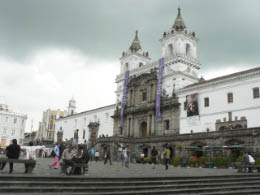
Francisca Square |
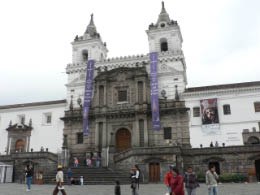
Francisca Square |
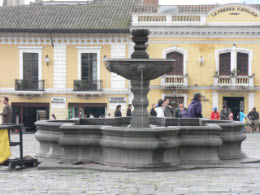
Francisca Square |
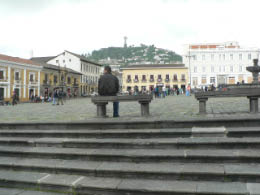
Francisca Square |
We didn’t go into the church, but visited the unique gift shops below the church. We enjoyed the cave-like shops and the wares.
I had a few minutes to do some serious people watching on the plaza – old guys reading their newspapers, mothers and their babies, young children playing and a couple of policemen with a couple of police dogs – making you wonder just who they're looking for?
From the square Sofy pointed out a hill in the distance (elevation almost 10,000 feet) located on the southernmost end of Old Town. It’s named El Panecillo because in Spanish, panecillo means small bread roll and the hill sort of looks like a little bread roll. On top of the hill is a huge (148 foot high) winged statue of the Virgin of Quito. Before the Spanish arrived, the Incas used the hill as a place to worship the sun. Later, from 1812-15, the Spanish constructed a fortress on the hill to check on things down below. Today, people go there to get magnificent views of the city. (We didn’t go – only viewed it from afar.)
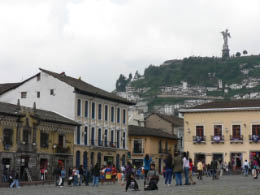
El Panecillo |
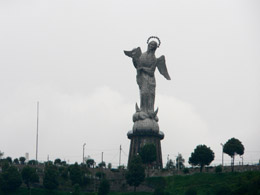
Virgin of Quito |
The morning went fast with all the places and new information and before we knew it, it was time for lunch. The bus took us to an apartment building for a “home hosted” lunch. Two of the families in the building served us lunch. Half our group went to one apartment; the other half across the hall to dine with another family. The young woman who invited us in was so charming and spoke very good English. Her mother-in-law was in the kitchen preparing the meal. She had two kids – a girl, age 4, and a little boy, age 2. The little girl was a pistol and wanted everyone’s napkin holder and attention. She danced and smiled and made faces for all our pictures. The lunch was fresh and good – Quinoa soup and potatoes and pork chops. The Dad came home later to give the Mom a hand. They made a great family. Our tour group is quiet -- no big-mouths to be found, thank goodness. We hadn’t gotten to know each other yet and we were tired and jet-lagged so we just sat and smiled while the kids bounced around us.
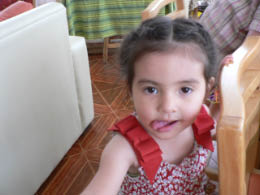
4-year old posing for photo |
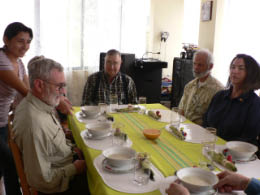
Our home-hosted lunch |
After an hour or so of lunch, the bus picked us up to take us to the equator. We drove about 45 minutes over rolling hills and green valleys interspersed with farms, gravel pits, and suburbs to house the growing population.
There are two equators in Ecuador: the fake equator with a real, official looking monument and the real equator with the fake stuff.
Our first stop was at the “real equator” as measured by Global Positioning System. The Inti Nan Museum (meaning Museum of the Path of the Sun) was billed as a museum, but was more like a shabby Disney version of the wonders of the equator and the region. We followed a path that lead to latitude 00:00:00 (AKA the equator). We passed through different plant gardens and a few scattered huts that housed alleged exhibits. One hut displayed a model of an indigenous guy dressed only with a strap around his waist that tied up his penis. We had a few laughs over that one. The group is getting to know each other better.
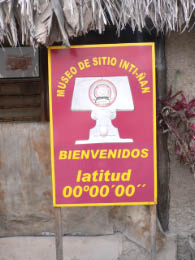
Inti Nan Museum |
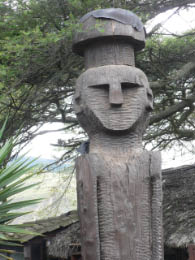
Inti Nan Museum |
We had a perky student guide who was lots of fun. She showed us a couple of ancient sundials. Sundials were very big if you’re an Inca and live on the equator. (There’s no shadow when the sun is directly overhead on those very special harvest and planting holidays.)
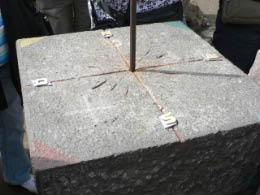
Sundial at the Equator |
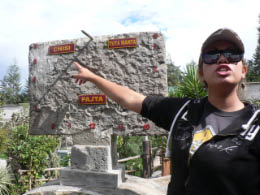
Our guide at the Inti Nan Museum |
Each of us in the group got our picture taken right on the equator. Then our guide lead us through several “experiments” to show we were indeed right smack dab in the middle of the world, between the northern and the southern hemisphere. By dragging a sink (with a drain) from place to place, she demonstrated the Coriolis effect , proving that water going down a drain rotates clockwise in the northern hemisphere and counter-clockwise in the southern hemispheres. She (and a couple of others from our group) could balance an egg on its end when placed directly on the equator. She had us try to walk down the equator line like a breathalyzer test and feel the off balance pull to each side. (I really couldn’t tell.) There were some other interactive, “fun with science” demos that taught us about earth’s bulging center. By the way, on the equator, you weigh less, because of the centrifugal force is greater, slightly countering the force of gravity.
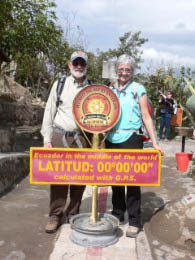
Bill and Nancy at the Equator |
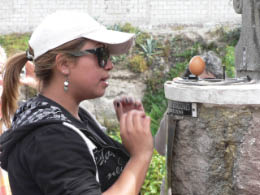
Balancing an egg |
After all the equator excitement, we stopped in at a hut with guinea pigs penned off in one corner. Our guild told us about raising guinea pigs, a delicacy in these parts. She also said the guinea pigs are active and agitated when disturbed and upset people are in the room. We have a very mellow group and the guinea pigs were very relaxed. Finally, the guide dropped us off at a gift shop masquerading as a weaving demo – nobody bought it.
We climbed on the bus for a five-minute ride down a dirt road to the “fake equator” with the real looking monument. The avenue leading to the Middle of the World (Mitad del Mundo) monument is lined with busts of important French members of the La Condamin’s expedition and looks very official. The expedition came here from France to do precise science (with their fancy gear and triangulation equipment) in order to determine the official Middle of the World between the northern and southern hemispheres. The folks on the expedition were the typical smug rich white guy know-it-all’s. They wouldn’t listen to the ignorant indigenous folks who knew where the real middle of the world was without the fancy equipment. (The indigenous folks only had the sun and heavens to guide them.) Consequently, the French spent a lot of money and went to a lot of effort to determine the location of the equator and then erected this expensive monument for their own legacy. (Too bad the monument isn’t in the right place.) I was impressed with the monument and took a lot of photos at the fake equator stop (La Mitad del Mundo), but had more fun on the real equator (Inti Nan).
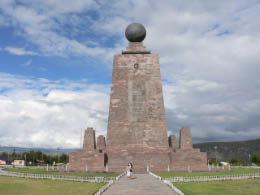
Mitad del Mundo monument |
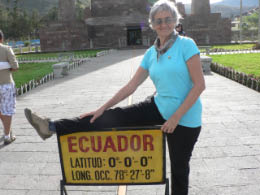
Nancy on the "fake" Equator |
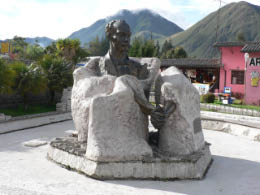
French guy |

Our group at the Mitad del Mundo |
My heart skipped a beat when I came out of the bathroom and saw our bus pulling out of the parking lot. I went running. I thought, Jez, these folks are serious about keeping a schedule. Bill asked the bus driver to stop for me.
We got back to the hotel with only a few minutes to spare before our evening briefing and our dinner. We had a good dinner at the hotel. Afterwards, we stayed to review with Sofy all the things we did today because the images in my brain had turned into a blur. She’s very knowledgeable and wants to make sure we have our questions answered.
In spite of being brain dead, we had to go to our room and sort and re-pack for the Amazon.
Thursday, April 21, 2011—Off to the Amazon
We got up early and finished packing – one little duffle bag for the Amazon and one larger suitcase left behind (with our netbook) at the hotel. We had a quick breakfast and loaded on the bus at 7:45.
On the way to the airport (to catch a plane to Coca and the Amazon), we stopped to visit the Sinamune Foundation music school for special needs children. Edgar Palacios, a well-known Ecuadorian musician, started the school in 1993 for children with developmental problems (Down syndrome, mental and visual disabilities, etc.) The kids are 12 years old and up. The place gives children a chance at life and a chance to express themselves through music. They have an orchestra and dance group and they gave us a performance of a lifetime. I especially enjoyed the dancers. At 8 in the morning they had us all smiling with glee. This morning, the band and the dance troupe had only about 20% of the kids – but they made up for it with heart. The school kids are in such demand, most of them were on the road. (Some were on Easter holiday.) It was touching to see the students– real miracles are happening here. I was moved by the way the teacher studied the face of each student. You could just feel his joy. For the last dance, some of us joined in – what a beautiful place. On the way out, I bought a few things at the gift shop.
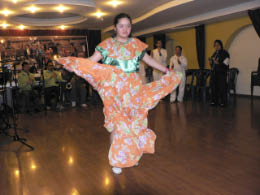
Sinamune Foundation music school |
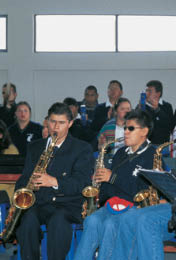
Sinamune Foundation music school |
We got back on the bus and went to the airport to board a VIP turboprop to the Jungle. Sofy and the bus driver took care of all the bags making our life easy.
Sofy traded places with me on the plane so I could have a window seat. She sat by Bill and I overheard their conversation. Bill is so charming. I took photos as we flew over the Andes to Coca. It was only a 30-minute flight. The clouds were beautiful, God-like, in fact, but they blocked the view of the volcanoes around Quito. As we neared the jungle, I saw some large bare areas where the Amazon primary forest had been hacked back. So sad.
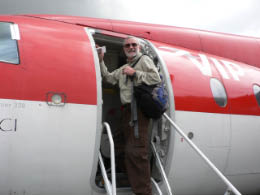
Bill (VIP) boarding VIP Airlines |
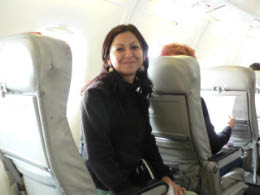
Sofy on the plane |
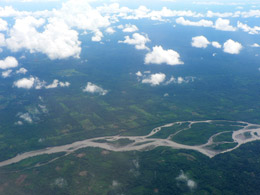
Napo River |
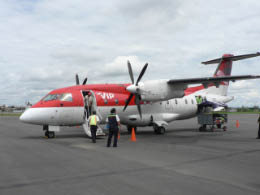
Turboprop to Coca |
| 










